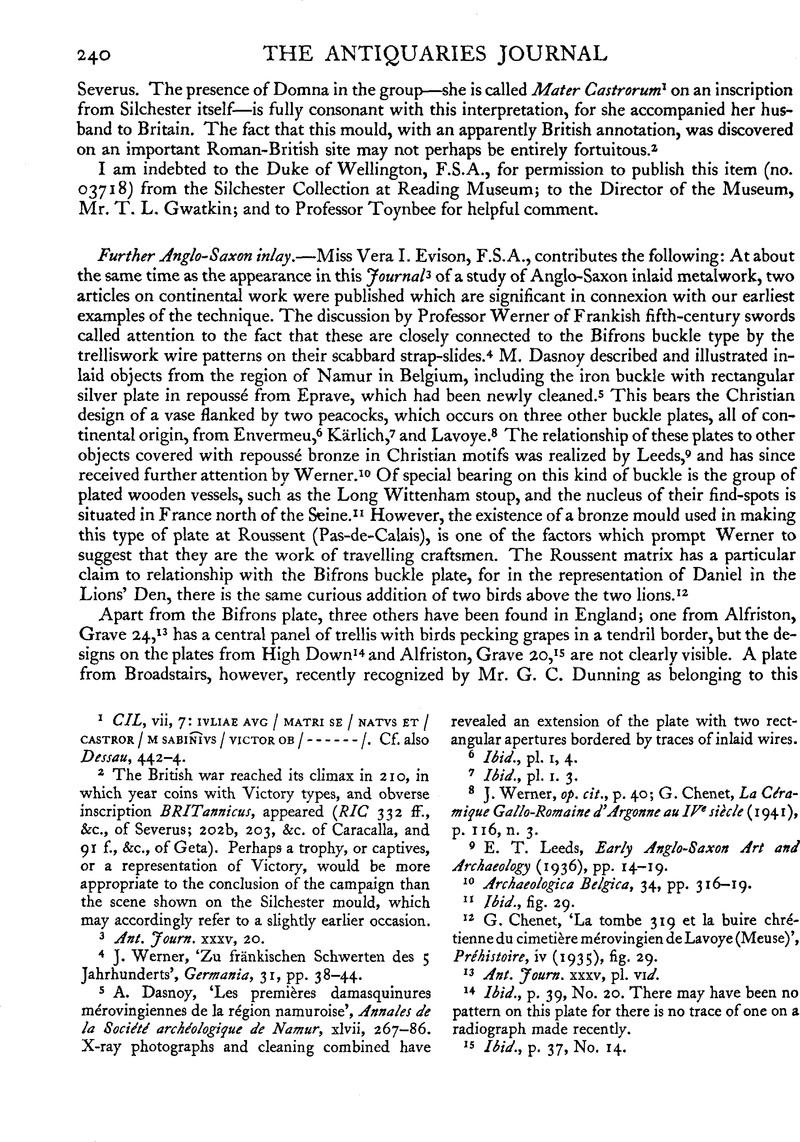Article contents
Further Anglo-Saxon inlay
Published online by Cambridge University Press: 29 November 2011
Abstract

- Type
- Notes
- Information
- Copyright
- Copyright © The Society of Antiquaries of London 1958
References
page 240 note 3 Ant. Journ. xxxv, 20.
page 240 note 4 Werner, J., ‘Zu fränkischen Schwerten des 5 Jahrhunderts’, Germania, 31, pp. 38–44.Google Scholar
page 240 note 5 Dasnoy, A., ‘Les premières damasquinures mérovingiennes de la région namuroise’, Annales de la Société archéologique de Namur, xlvii, 267–86.Google Scholar X-ray photographs and cleaning combined have revealed an extension of the plate with two rectangular apertures bordered by traces of inlaid wires.
page 240 note 6 Ibid., pl. 1, 4.
page 240 note 7 Ibid., pl. 1. 3.
page 240 note 8 Werner, J., op. cit., p. 40Google Scholar; Chenet, G., La Céramique Gallo-Romaine d'Argonne au IVe siècle (1941), p. 116Google Scholar, n. 3.
page 240 note 9 Leeds, E. T., Early Anglo-Saxon Art and Archaeology (1936), pp. 14–19.Google Scholar
page 240 note 10 Archaeologica Belgica, 34, pp. 316–19.
page 240 note 11 Ibid., fig. 29.
page 240 note 12 Chenet, G., ‘La tombe 319 et la buire chrétienne du cimetière mérovingien de Lavoye (Meuse)’, Préhistoire, IV (1935)Google Scholar, fig. 29.
page 240 note 13 Ant. Journ. XXXV, pl. VII.
page 240 note 14 Ibid., p. 39, No. 20. There may have been no pattern on this plate for there is no trace of one on a radiograph made recently.
page 240 note 15 Ibid., p. 37, No. 14.
page 241 note 1 Ibid., p. 23, n. 3; in repoussé, Envermeu, Dasnoy, A., op. cit., pl. 1, 4Google Scholar, inlay-High Down, , Ant. Journ. XXXV, pl. VIGoogle Scholar, d.
page 241 note 2 Thorpe, W. A., English Glass (1935), pl. XGoogle Scholara. Dark Age Britain (1956), Harden, D. B., ‘Glass vessels in Britain and Ireland, A.D. 400–1000’, pp. 139 and 159.Google Scholar
page 241 note 3 P.S.A. xxiii, 273.
page 241 note 4 Salin, B., Die germanischen Thierornamentik, pp. 158–60.Google Scholar For examples on early square-headed brooches, see Leeds, E. T., A Corpus of Early Anglo-Saxon Great Square-headed Brooches (1949)Google Scholar, figs. S. 5, S. 6, S. 7, S3, 71.
page 241 note 5 Since the above was written, a similar buckle with kidney-shaped loop from Normée (Marne) has been noticed at Épernay museum. The border triangles are without circles and the peacocks' tails end in four ringlets. The drawing in Coutil, L., Archéologie gauloise, gallo-romaine, franque et carolingienne II, opp. p. 98Google Scholar, No. 50 seems to be a plate with tendrils (from St. Pierre-du-Vauvray), probably the silver plate on iron 1·8 in. × 1·1 in. in Louviers Museum.
page 241 note 6 B.M. Anglo-Saxon Guide, fig. 38.
page 241 note 7 Leeds, E.T., Early Anglo-Saxon Art and Archaeology, pl. IIIc.Google Scholar
page 242 note 1 Ant. Journ. XXXV, pl. IVa.
page 242 note 2 Wheeler, R. E. M., London and the Saxons, Grave 29, pp. 129–31Google Scholar, fig. 14.
page 242 note 3 Brent, J., Canterbury in Olden Time (1879), pl. 2, 4.Google Scholar
page 242 note 4 Sussex A.C. lvi, pl. VIII, 6.
page 242 note 5 Glazema, P. and Ypey, J., Merovingische Ambachtskunst (1956), pl. 22.Google Scholar
page 242 note 6 Baldwin Brown, G., The Arts in Early England, iii, pl. LIIGoogle Scholar, 8, but the material of the plate is here wrongly described as bone.
page 242 note 7 Ant. Journ. XXXV, pl. VIII, a.
page 242 note 8 Warhurst, A., Arch. Cant, lxix, pl. IX, 4.Google Scholar
page 242 note 9 Ant. Journ. XXXV, pl. IIIg.
page 242 note 10 Excavated by Mr. Frank Jenkins, F.S.A., who has very generously allowed publication here.
page 243 note 1 Werner, J., Germania, 31, p. 40.Google Scholar
page 243 note 2 Lincs. Arch. and Arch. Soc., N.S. V, 81, fig. 1, 4.
page 243 note 3 Ant. Journ. xxiv, pl. XXIX, a.
page 243 Note 4 Leeds, E. T., and Shortt, H. de S., An Anglo-Saxon Cemetery at Petersfinger (1953), fig. 6, pl, II.Google Scholar I am grateful to Mr. Shortt, who noticed traces of bronze on the socket and kindly sent the spear for X-ray.
page 243 note 5 Evison, V. I., ‘An Anglo-Saxon Cemetery at Holborough, Kent’, Arch. Cant. lxx, 97Google Scholar, fig. 7 and pl. IIIa.
page 244 note 1 P.S.A. XV, 178.
page 244 note 2 Behmer, E., Das zweischneidige Schwert (1939)Google Scholar, Taf. LX, 4.
page 244 note 3 Reg. No. 1909.563, provenance unknown.
page 244 note 4 Werner, J., Das alamannische Gräberfeld von Bulach (1953)Google Scholar, a buckle from Kaiseraugst, Taf. XXX, 2, and ibid.Das alamannische Gräberfeld von Mindelheim (1955), a counter-plate, Taf. 21, 124, 2a. Both have the semicircle and T-cell motif, and belong to the seventh century.
- 3
- Cited by




